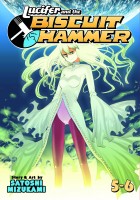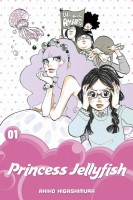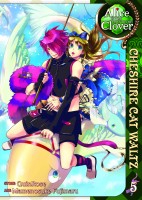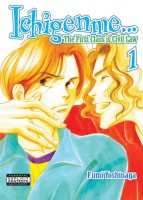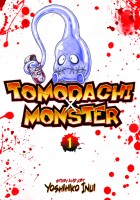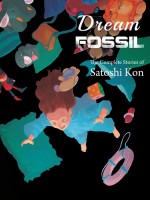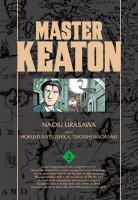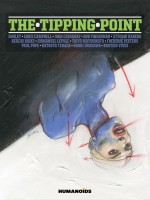My News and Reviews
In case anyone was wondering just how much I was looking forward to seeing Akiko Higashimura’s Princess Jellyfish released in English, I apparently ended up devoting an entire week to it at Experiments in Manga. (Sort of.) First was the announcement of the winner of the Princess Jellyfish giveaway, which also includes a list of upcoming manga releases that I and the giveaway participants are especially looking forward to. (Yes, Princess Jellyfish was mentioned multiple times, and not just by me.) The honor of the first in-depth manga review for April goes to the first Princess Jellyfish omnibus which I (unsurprisingly) loved. I’m enjoying the manga immensely, but I’m especially looking forward to getting to the point in the series where the anime adaptation left off. Princess Jellyfish even got a specific mention in March’s Bookshelf Overload, which was posted over the weekend.
There were a few manga-related things caught my eye last week. Brigid Alverson’s article on the state of the North American manga industry, which focuses on the impact of a few of the top-selling series, is now free to read at Publishers Weekly. The translation and quality of Digital Manga’s original release of the first volume of Kou Yoneda’s Twittering Birds Never Fly drew a fair amount of criticism from fans, so much so that the publisher decided to completely revise and re-release it. Apparently 200 of the 223 pages were redone in some fashion. The new edition should be available sometime in late May or early June. Also, Vertical launched it’s most recent licensing and readership survey for anyone who might have any manga or light novel requests. And last but certainly not least—Kodansha Comic’s will be releasing more of Vinland Saga!
Quick Takes
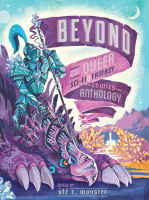 Beyond: The Queer Sci-Fi & Fantasy Comic Anthology edited by Sfé R. Monster. A fair number of independent queer comics anthologies have been released relatively recently, but I’m always happy to see more. Beyond collects twenty works from twenty-seven creators. I was previously familiar with a few of the contributors, but most of them were actually new to me. Overall, it’s a strong, well-thought-out collection. The anthology shows a wonderful range of stories and characters, but I was especially happy to see a wide variety of diverse trans identities represented. While many of the works in Beyond include some romantic elements, romance isn’t at all at the forefront of the collection. Instead, the stories tend towards science fictional and fantastical adventures—space exploration, battles against monsters, survival in strange worlds, and so on—in which queer characters are not only the protagonists but the heroes of their stories. A second Beyond anthology focusing on urban fantasy and post-apocalyptic worlds is currently in the works; I’m looking forward to it a great deal and will definitely be picking it up.
Beyond: The Queer Sci-Fi & Fantasy Comic Anthology edited by Sfé R. Monster. A fair number of independent queer comics anthologies have been released relatively recently, but I’m always happy to see more. Beyond collects twenty works from twenty-seven creators. I was previously familiar with a few of the contributors, but most of them were actually new to me. Overall, it’s a strong, well-thought-out collection. The anthology shows a wonderful range of stories and characters, but I was especially happy to see a wide variety of diverse trans identities represented. While many of the works in Beyond include some romantic elements, romance isn’t at all at the forefront of the collection. Instead, the stories tend towards science fictional and fantastical adventures—space exploration, battles against monsters, survival in strange worlds, and so on—in which queer characters are not only the protagonists but the heroes of their stories. A second Beyond anthology focusing on urban fantasy and post-apocalyptic worlds is currently in the works; I’m looking forward to it a great deal and will definitely be picking it up.
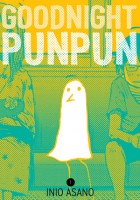 Goodnight Punpun, Omnibus 1 by Inio Asano. The first omnibus of Goodnight Punpun is one of the manga that has left the greatest impression on me so far this year, though I have difficulty coherently explaining why I find it so extraordinary. The series has been described as a surreal and dark coming-of-age story, which is accurate but doesn’t quite capture the intense experience of actually reading the manga. Punpun is the titular character, an elementary school student who, along with the rest of his family, is portrayed as a bird-like creature. This perhaps slightly softens the blows of the story. In addition to dealing with the normal sorts of problems associated with getting older, Punpun’s family is also violently falling apart. And if growing up wasn’t terrifying enough, most of the adults in Goodnight Punpun seem to be on the verge of insanity if they haven’t already succumbed to it. Although there are wonderful moments of hope and humor, the worldview presented in Goodnight Punpun is a pessimistic one and Punpun is learning some very hard truths. Goodnight Punpun is heart-wrenching, but very good.
Goodnight Punpun, Omnibus 1 by Inio Asano. The first omnibus of Goodnight Punpun is one of the manga that has left the greatest impression on me so far this year, though I have difficulty coherently explaining why I find it so extraordinary. The series has been described as a surreal and dark coming-of-age story, which is accurate but doesn’t quite capture the intense experience of actually reading the manga. Punpun is the titular character, an elementary school student who, along with the rest of his family, is portrayed as a bird-like creature. This perhaps slightly softens the blows of the story. In addition to dealing with the normal sorts of problems associated with getting older, Punpun’s family is also violently falling apart. And if growing up wasn’t terrifying enough, most of the adults in Goodnight Punpun seem to be on the verge of insanity if they haven’t already succumbed to it. Although there are wonderful moments of hope and humor, the worldview presented in Goodnight Punpun is a pessimistic one and Punpun is learning some very hard truths. Goodnight Punpun is heart-wrenching, but very good.
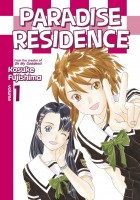 Paradise Residence, Volume 1 by Kosuke Fujishima. Oh My Goddess! has been one of the mainstays of the North American manga industry, so it’s probably no too surprising that one of Fujishima’s most recent series, Paradise Residence, was licensed. I’m not entirely sure if the series is being released in an omnibus edition or not, but the first volume from Kodansha Comic’s also includes Volume 0 as bonus material at the end. I would actually recommend reading Volume 0 first as some of the jokes and characterization in Volume 1 make much more sense with more context. This is important because the humor, which can be legitimately if inconsistently funny, tends to be based on the characters’ personalities. Despite some of the more outrageous scenarios in Paradise Residence, the comedy is actually fairly subdued. Paradise Residences is a largely episodic manga about dorm and school life at an all-girls boarding school. At times Paradise Residence can be a really sweet and charming series, but every once in a while some nonsensical fanservice is thrown in that’s more distracting than anything else.
Paradise Residence, Volume 1 by Kosuke Fujishima. Oh My Goddess! has been one of the mainstays of the North American manga industry, so it’s probably no too surprising that one of Fujishima’s most recent series, Paradise Residence, was licensed. I’m not entirely sure if the series is being released in an omnibus edition or not, but the first volume from Kodansha Comic’s also includes Volume 0 as bonus material at the end. I would actually recommend reading Volume 0 first as some of the jokes and characterization in Volume 1 make much more sense with more context. This is important because the humor, which can be legitimately if inconsistently funny, tends to be based on the characters’ personalities. Despite some of the more outrageous scenarios in Paradise Residence, the comedy is actually fairly subdued. Paradise Residences is a largely episodic manga about dorm and school life at an all-girls boarding school. At times Paradise Residence can be a really sweet and charming series, but every once in a while some nonsensical fanservice is thrown in that’s more distracting than anything else.



